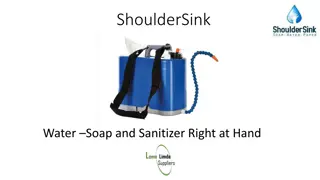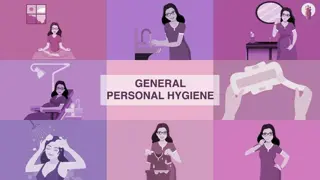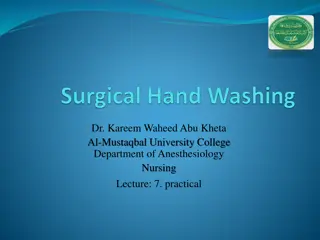Importance of Hand Hygiene in Infection Prevention
Hand hygiene is crucial in preventing the spread of infections, especially in healthcare settings where patients are vulnerable. Lack of proper hand hygiene can lead to Hospital Acquired Infections (HAIs), adding significant costs to healthcare and posing serious risks to patients. It is essential to follow proper handwashing techniques and use antimicrobial agents to reduce the spread of pathogens and protect patients from communicable diseases.
Download Presentation

Please find below an Image/Link to download the presentation.
The content on the website is provided AS IS for your information and personal use only. It may not be sold, licensed, or shared on other websites without obtaining consent from the author.If you encounter any issues during the download, it is possible that the publisher has removed the file from their server.
You are allowed to download the files provided on this website for personal or commercial use, subject to the condition that they are used lawfully. All files are the property of their respective owners.
The content on the website is provided AS IS for your information and personal use only. It may not be sold, licensed, or shared on other websites without obtaining consent from the author.
E N D
Presentation Transcript
HAND HYGIENE Claudia J. Grooms, RN, MSN
INFECTION Invasion of a susceptible host by pathogens or micro-organisms resulting in disease. COMMUNICABLE DISEASE ANTISEPTIC AGENT antimicrobial substance that is applied to the skin to reduce the number of microbial flora (ex: alcohol,chlorhexidine, chlorine) HANDWASHING washing hands with plain (non-antimicrobial) soap & water HAND HYGIENE Handwashing Antiseptic handwash or Antiseptic hand rub Alcohol-based hand rub CHAIN OF INFECTION Many diseases and conditions are spread by not washing hands with soap and clean, running water. 3
Infectious agent or pathogen Reservoir or source for pathogen growth Portal of exit Mode of transmission Portal of entry Susceptible host HANDWASHING
# 1 Hand Hygiene is the #1 way to prevent the spread of infections! Especially: *common cold *Flu *Staph infections *C. Diff 5
The incidence of patients developing infection as the direct result of contact is increasing Current trends, public awareness, and rising costs of health care have increased the importance of infection prevention and control. 2 million Hospital Acquired Infections (HAI) each year OR 1 :20 (1 infection for every 20 patients) Hospital infections add over $30.5 billion a year to hospital costs.(average additional cost of $15,275 when a patient contracts an infection) 6
CDC: in charge of tracking and preventing HAIs Acute care hospitals are required to report these data to the CDC Medicare.gov Compare the Quality of Care and Services of Health Care Providers in your area. Infections that patients get in the hospital can be life- threatening and hard to treat Increased Patient Length of Stay time away from home, work, family Increased Mortality: approximately 103,000 persons die annually from HAIs 7
ALL patients are at risk for hospital infections Patients at greater risk for health-care associated infections (HAIs) Multiple illnesses Older adults Poorly nourished Lowered resistance to infection Increased Drug resistance 8
Risk factors Number of health care employees with direct contact with the patient Types and numbers of invasive procedures Therapy received Length of hospitalization Major sites for HAI infection Surgical or traumatic wounds Urinary and respiratory tracts Ventilator- Associated Pneumonia (VAP) Bloodstream (Central Line Associated Bloodstream Infections (CLABSIs)
Every Individual PATIENTS FAMILY VISITORS NURSES DOCTORS OTHER HEALTHCARE PROVIDERS 10
THE most important technique to use in preventing and controlling transmission of infection. WHO: World Health Organization Wash hands with clean, running water and soap (liquid soap if possible) If clean, running water is not accessible use soap and available water. If soap and water are unavailable, use an alcohol-based hand sanitizer that contains at least 60% alcohol to clean hands. 11
WHEN TO USE WHAT 12 USE SOAP & WATER -when hands are visibly soiled & look dirty -after any toileting -before you eat or prepare food USE ALCOHOL-BASED HAND RUB -When hands do not look dirt -If soap & water are not available
When should you perform hand hygiene? Before, during & after preparing food Before eating food After using the toilet or changing a diaper After blowing your nose, coughing or sneezing Before & after giving care to a sick person Before & after treating a cut or wound Before inserting & removing contact lenses After handling garbage, chemicals, equipment or anything else that could be contaminated After touching an animal or animal waste SPEAK Up: Ask your nurses and doctors to clean their hands before they examine you Before & After Gloving never leave a patient room with gloves on 13
When should you wash your hands? Entering and leaving a patient room Before putting on gloves After removing gloves *Wearing gloves alone is not enough to prevent the spread of infection Before & After Gloving never leave a patient room with gloves on Prior to and after performing procedures especially invasive Handling equipment Before and after assisting a patient with toileting Handling patient personal items After blowing your nose, coughing or sneezing Before & after treating a cut, wound, IV, Foley After handling garbage, chemicals, equipment or anything else that could be contaminated Additional: same as patient GEL IN AND GEL OUT 14
1. Gloves are an additional barrier to bacterial transfer. 2.Two methods of gloving: open and closed. 3. Open method: used on general procedures like dressing changes or urinary catheter insertion. 4. Closed gloving method practiced in operating rooms and skilled areas and take place after you apply a sterile gown. 5. Important that you have the right glove size where they do not tear. 16
Sterile Gloving - Video How To 1. Hand wash and remove jewelry 2. Remove outer glove package 3. Take enter package and lay on clean flat surface just above waist level. 4. Open package by lifting lip to the top first and to the bottom second. 5. Identify right and left glove the cuff is 5cm wide. Glove dominate hand first. 6. With thumb and first two fingers of non-dominant hand, grasp edge of cuff of glove. Only touch outside of cuff. 7.Pull glove over hand slowly be sure cuff does not roll up wrist and fingers are in the right slots. 8.With gloved right hand slip fingers under cuff of remaining glove .Pull gently on. ( see diagram) 9. After gloved interlock hands. 17
Creative Commons License This work is licensed under a Creative Commons Attribution 4.0 International License. Except where otherwise noted, this content by Southern Regional Technical College is licensed under the Creative Commons Attribution 4.0 International License. To view a copy of this license, click https://creativecommons.org/licenses/by/4.0/ Healthcare Careers Work!(HCW) is sponsored by a $2.3 million grant from the U.S. Department of Labor, Employment & Training Administration. TAACCCT Grant #TC- 26488-14-60-A-13. Southern Regional Technical College is an equal opportunity employer and will make adaptive equipment available to persons with disabilities upon request. This workforce product was funded by a grant awarded by the U.S. Department of Labor s Employment and Training Administration. The product was created by the grantee and does not necessarily reflect the official position of the U.S. Department of Labor. The U.S. Department of Labor makes no guarantees, warranties, or assurances of any kind, express or implied, with respect to such information, including any information on linked sites and including, but not limited to, accuracy of the information or its completeness, timeliness, usefulness, adequacy, continued availability, or ownership.























